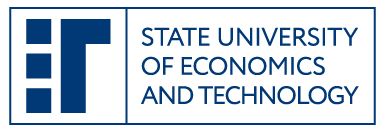GeoGebra with augmented reality as a tool for teaching mathematics in the training of specialists in the field of management and administration
DOI:
https://doi.org/10.62911/ete.2025.03.01.05Keywords:
GeoGebra; augmented reality; teaching mathematics; spatial thinking; visualization; digital tools; project-based learning.Abstract
Abstract: The rapid development of digital technologies and the growing demand for practice-oriented education have led to a rethinking of approaches to mathematics teaching, especially in training future specialists in the field of management and administration. Mathematical knowledge plays a key role in economic and financial decision-making, requiring a deep understanding of spatial relationships, analytical structures, and quantitative dependencies. However, students in higher education often struggle with abstract mathematical concepts, which affects their motivation and professional self-identification. This study explores the potential of the GeoGebra software environment with augmented reality (AR) as a modern tool for enhancing mathematics learning among students of financial and economic specialties. It includes a theoretical review of international literature on AR technologies in education and an experimental test involving students majoring in “Finance, Banking, Insurance, and Stock Market”. The experimental group used the GeoGebra 3D Calculator with AR to solve geometric, algebraic, and financial math problems, while the control group applied traditional methods. The results revealed improved spatial understanding, increased motivation, and better academic performance among students using AR-based visualizations. Additionally, project-based learning activities with GeoGebra AR helped link mathematical theory to real-world financial applications. The study confirms the effectiveness of integrating GeoGebra AR into higher education mathematics curricula and provides methodological recommendations. This approach enhances mathematical training quality and supports the development of digital skills and professional competencies of future specialists in the field of management and administration.
References
Batubara, I. H., Saragih, S., Simamora, E., Napitupulu, E. E., Nuraini, N., Sari, D. N., Anim, A., Sari, I. P., Rahmadani, E., & Syafitri, E. (2022). Improving student mathematics communication ability through problem-based learning assisted by augmented reality based on culture. AIP Conference Proceedings, 2659, 5. https://doi.org/10.1063/5.0113258
Cheong, K. H., Chu, C. E., Ng, W. K., & Yeo, D. J. (2024). Implementing GeoGebra 3D Calculator with Augmented Reality in multivariable calculus education. IEEE Access, 12, 85455–85464. https://doi.org/10.1109/ACCESS.2024.3394531
Garzón, J., & Acevedo, J. (2020). Meta-analysis of the impact of Augmented Reality on students’ learning gains. Educational Research Review, 27, 100254, 244–260. https://doi.org/10.1016/j.edurev.2019.04.001
Garzón, J., Pavón, J., & Baldiris, S. (2019). Systematic review and meta-analysis of augmented reality in educational settings. Virtual Reality, 23(4), 447–459. https://doi.org/10.1007/s10055-019-00379-9
Ibáñez, M.-B., & Delgado-Kloos, C. (2018). Augmented reality for STEM learning: A systematic review. Computers & Education, 123, 109–123. https://doi.org/10.1016/j.compedu.2018.05.002
Lainufar, M., Mailizar, M., & Johar, R. (2021). Exploring the potential use of GeoGebra augmented reality in a project-based learning environment: The case of geometry. Journal of Physics: Conference Series, 1882(1), 012045. https://doi.org/10.1088/1742-6596/1882/1/012045
Lytvynova, S., Burov, O., & Semerikov, S. (2020). Conceptual approaches to the use of augmented reality means within the educational process. Modern Information Technologies and Innovation Methodologies of Education in Professional Training: Methodology, Theory, Experience, Problems, 55, 46–62. https://doi.org/10.31652/2412-1142-2020-55-46-62
Shabanova, M., Bezumova, O., Zatsepina, E., Malysheva, S., Kotova, S., & Ovchinnikova, R. (2020). Learning stereometry in a secondary school within GeoGebra’s augmented reality app. Journal of Physics: Conference Series, 1691(1), 012115. https://doi.org/10.1088/1742-6596/1691/1/012115
Petrov, P. D., & Atanasova, T. V. (2020). Developing Spatial Mathematical Skills Through Augmented Reality and GeoGebra. In ICERI2020 Proceedings (pp. 5719–5723). ICERI. https://doi.org/10.21125/iceri.2020.1229
Rashevska, N. V., Semerikov, S. O., Zinonos, N. O., Tkachuk, V. V., & Shyshkina, M. P. (2020). Using augmented reality tools in the teaching of two-dimensional plane geometry. In O. Y. Burov & A. E. Kiv (Eds.), Proceedings of the 3rd International Workshop on Augmented Reality in Education, Kryvyi Rih, Ukraine, May 13, 2020 (CEUR Workshop Proceedings, Vol. 2731, pp. 79–90). CEUR-WS.org. https://ceur-ws.org/Vol-2731/paper03.pdf
Vakaliuk, T. A., & Pochtoviuk, S. I. (2021). Analysis of tools for the development of augmented reality technologies. In S. H. Lytvynova & S. O. Semerikov (Eds.), Proceedings of the 4th International Workshop on Augmented Reality in Education (AREdu 2021), Kryvyi Rih, Ukraine, May 11, 2021 (CEUR Workshop Proceedings, Vol. 2898, pp. 119–130). CEUR-WS.org. https://ceur-ws.org/Vol-2898/paper06.pdf










